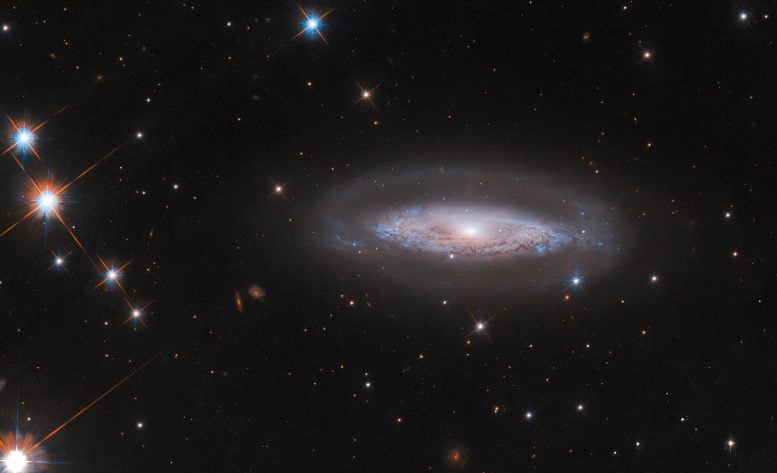

This week, the Hubble Space Telescope captivates us with a stunning image of the spiral galaxy IC 4709, located 240 million light-years away in the constellation Telescopium.
The image reveals a brilliant core powered by a massive black hole, emitting light across the electromagnetic spectrum, from infrared to X-rays. This detailed capture is part of a broader effort involving multiple telescopes, including ESA’s Euclid, to study such phenomena in both local and distant galaxies.
A Galactic Showcase
The Hubble Space Telescope has a lot to show in this spectacular image. Its view here is studded with stars, many of which appear particularly large and bright thanks to their nearby locations in our own galaxy, and which feature the characteristic diffraction patterns caused by Hubble’s optics.
Much further away — around 240 million light-years distant, in fact, in the southern constellation Telescopium — is the spiral galaxy IC 4709. Its swirling disc filled with stars and dust bands is beautifully captured, as is the faint halo surrounding it.
The compact, glowing region at its core might be the most remarkable sight, however: this is an active galactic nucleus (AGN). Bright as it appears in this visible-light image from Hubble, it’s even powerful across the rest of the spectrum of light.
Unveiling the Core: IC 4709’s Luminous Center
If IC 4709’s core were just filled with stars, it would not be nearly so bright. Instead, it hosts a gargantuan black hole, 65 million times the mass of our Sun. A disc of gas spirals around and eventually into this black hole, with the gas crashing together and heating up as it spins. It reaches such high temperatures that it emits vast quantities of electromagnetic radiation, from infrared to visible to ultraviolet light and beyond — in this case including X-rays.
To understand this brilliant astrophysical phenomenon, it’s necessary to study the whole spectrum of its emission. The high-resolution view of the Hubble Space Telescope not only can collect lots of light from the optical emission of the AGN, it also makes it possible to study the interaction between the quite small AGN and its host galaxy in detail.
Cross-Spectrum Analysis: Insights From Multiple Telescopes
This image incorporates data from two Hubble surveys of nearby AGNs that were identified by the Swift X-ray/UV telescope, as does the image from last week. Along with more Swift data, and this data from Hubble, ESA’s Euclid telescope — currently surveying the dark Universe in infrared light — will also image IC 4709 and other local AGNs.
Nearby black holes like these can help us to understand the ones present in the most distant galaxies, and the complementary use of space telescopes across the electromagnetic spectrum is key to fully researching them.